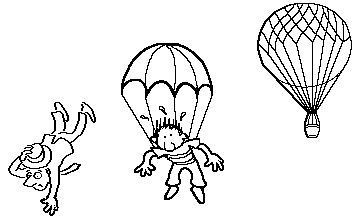 Gravity Index -
Introduction
Gravity Index -
Introduction
Weight Drop Experiment
Background Information - Forces Acting on Falling Objects
When an object is raised and then allowed to fall, three forces operate:
- Gravity - a force that pulls all objects towards the centre of the Earth.
All objects fall at the same rate, if gravity is the only force acting.
- Air resistance - a force that builds up as a falling object speeds up.
The faster an object falls, the higher its air resistance becomes. Evenually air
resistance equals the force of gravity and the object then falls, until it hits
the ground at a constant speed, called terminal velocity. Different objects have
different air resistances and different terminal velocities. A parachute, for
example, increases a falling person's air resistance and reduces termimal velocity
to a safe value.
- Buoyancy - a force that lifts an object upwards by an amount equal to the
weight of air displaced by the object. For many objects, the weight of the air
displaced is insignificant and the effect of buoyancy is not noticed. For large,
light objects such as hot air balloons, a lot of air is displaced and the
force of buoyancy is greater than the force of gravity, causing the object to
rise.
Tasks
- Read the background information above. Watch the weight drop movies
and study the frame by frame sequence of falling weights.
Start a new Word Document. Complete the following:
- Do heavy and light objects drop together? Illustrate your answer with a pair
of frames.
- Do objects fall at a constant speed? Note: the camera takes a frame every
4/100 ths of a second. Illustrate your answer by pasting multiple images of
a stone onto a single frame to show its path.
- The image of the falling golf ball in the frame by frame sequence
is round in the early frames but stretched in the later frames. Paste copies of
two frames that show this. Explain why the stretching occurs. Note: the shutter of the camera
stayed open for 1/100 th of a second when taking each frame.
- How could the experiment be improved?
Suggest how you could:
- Make the objects more visible.
- Drop the objects at exactly the same time.
- Ensure that an object is not given a slight push.
- Keep the camera steady.
- Make other improvements.
- View Dropping Weights in Airless Conditions. Answer the following:
- When did Apollo 15 land on the Moon?
- What does the surface of the Moon look like where Apollo 15 landed?
Illustrate your answer with an image.
- Who was the Astronaut who dropped the hammer and the feather?
- Why did he wear a spacesuit?
- On Earth, hammers fall faster than feathers. Why do they fall together on the Moon?
- How could you show that on Earth, a feather would fall as fast as a stone, if there
was no air? Illustrate you answer.
Michael Gallagher, October 2001
 Gravity Index -
Introduction
Gravity Index -
Introduction